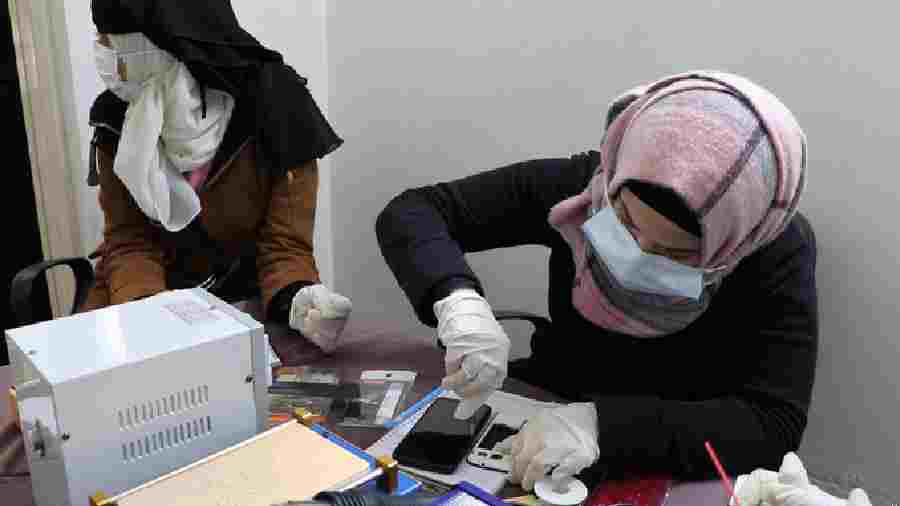About six weeks ago, Moufida Rahmon started seeing her neighborhood with different eyes. Ever since the 38-year-old opened her own small dairy business at the refugee camp Maarat Misrin, just north of Idlib, her neighbors became her customers — and potential customers.
"I was able to make $40 during the first month, which was enough to feed my sons and me," the mother of two told DW.
Her eyes tell how proud she is. "It's the first time that I feel hope for a better life after everything that happened in the past years," she said.
On August 29, 2012, just over a year into the war, Rahmon's husband became one of the many people disappeared.
Initially, she had decided to stay in the family's house in Al-Tah, but, after Russia entered the war on behalf of Syria's government in 2015, her place went up in flames following Russian shelling.
"I lost my home, everything we owned, and we had to flee overnight when Syrian regime forces seized the town," she said.
Since then, she and her children had been living in absolute poverty in a small tent in the refugee camp Maarat Misrin.
Rahmon and her family had depended on international aid for support as she had neither studied nor trained for a job.
Earlier this year, the camp management approached Rahmon with an idea. "They offered me a vocational training in the dairy business," she said. "Other women encouraged me and promised to buy my products," she added.
After a 15-day intensive course and a $800 project grant from the UN Office for the Coordination of Humanitarian Affairs, which enabled her to buy products and tools, she set up shop in her tent.
So far, her neighbors have kept their word and are buying her milk products, as well as ordering milk and cheese. "I really hope that this business will expand and will enable me to change our situation for good," she said.
As a consequence of the deteriorated economic conditions, the ongoing armed conflict and the lack of male breadwinners, Rahmon is by far not the only Syrian woman who entered the labor market for the first time.
According to this year's Syria Economic Monitor report by the World Bank, women's workforce participation doubled from 13% in 2010 to 26% in 2021. In comparison, the proportion of men increased only slightly, from 72% to 76%, over the same period.

Syrian women have excelled in the formerly male-dominated phone repair industry Deutsche Welle
New directions
Since 2017, the UN's Syria Cross-Border Humanitarian Fund has invested $76 million into 67 small scale businesses, vocational trainings and seed grants in Syria's northwest. "Fifty-one percent of the people supported by these interventions are women," Madevi Sun-Suon, spokeswoman of the Turkish United Nations Office for the Coordination of Humanitarian Affairs, told DW.
One of these projects is the Spark of Hope organization in downtown Idlib, which is run by Sawsan Saeed. "I support women at thinking out of the box," the energetic 48-year-old told DW.
One of her most recent ideas was to train women to repair mobile phones — a business in Syria that used to be entirely in the hands of men.
And yet it didn't take her long to find an instructor and enough interested women to start the course. "The women excelled in it and are very busy now," Saeed said.
Twenty-three-year-old Enas Manna applied for UN-financed vocational training as photographer. "Since I didn't have the money to complete my studies at the University of Idlib, I felt lost for about a year," she told DW. However, following the training, she opened her own photo studio and even employed a couple of women. "This opportunity helped me to make enough money to return to university despite the ongoing war," she said.
Changing face of Idlib
Over 11 years of civil war, life has become increasingly precarious in the region surrounding Idlib, formerly an agriculturally rich part of Syria.
According to the UN, 2.8 million displaced people live in 1,500 refugee camps in this region, one of the last strongholds of resistance against Syrian President Bashar al-Assad and his allies.
"These civilians in and around Idlib are still resisting the Assad-regime, just like the various armed groups who found shelter in this area. In turn, the social structure of this region has changed significantly," Anna Fleischer, head of the Beirut office of the Heinrich Böll foundation, told DW.
It is fair to say that this situation hasn't improved the lives of women either.
"On the one hand, women in Idlib fear the Syrian military and the Russian forces, and on the other hand, the Islamist militias like Hayat Tahrir Sham and others are also not the biggest fans of the idea that women read, work and are financially independent," Fleischer said.
Fleischer, who previously worked for the Women Now for Development organization also knows firsthand about many projects that continue in the Idlib region after activists are forced out of cities that have fallen back into the hands of Syria's regime. "However, in Idlib, they have to work under the radar," she said.











